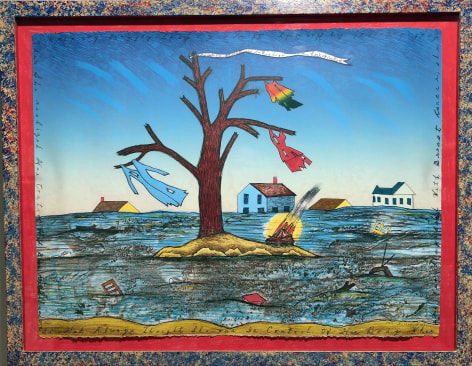
Hollis Sigler
To Have Power Is To Realize Our Lack of Control
Edition: 5/32
1994
Border Text:
She Had Always Thought She Was In Control Of Her Body. When
She Was Diagnosed With Breast Cancer, she felt
betrayed By her body. It was her Body letting her down.
Then She Realized Her Control Had Been An Illusion
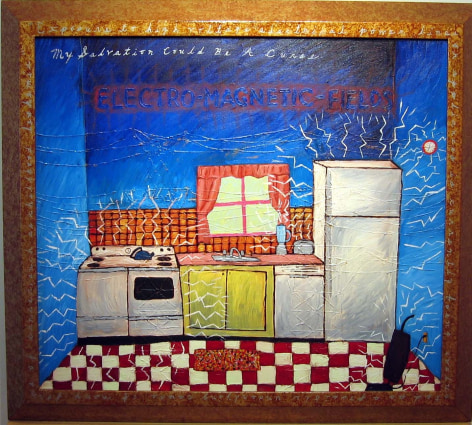
My Solution Could Be a Curse - Electro Magnetic Fields
is Being Evaluated as a Underlying Cause of Cancer
1995
Oil on canvas with painted frame
32 x 35 inches
HS 70
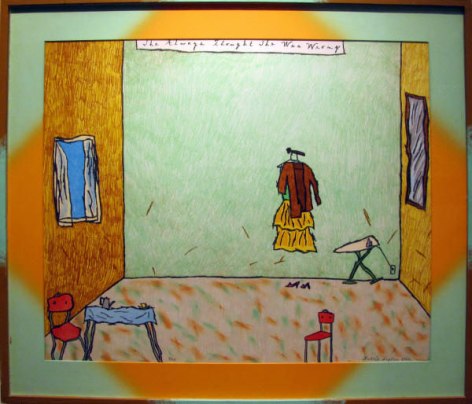
She Always Thought She Was Wrong
1982
Lithograph Edition: 7/35
21 x 25 inches with artist made frame
HS 31
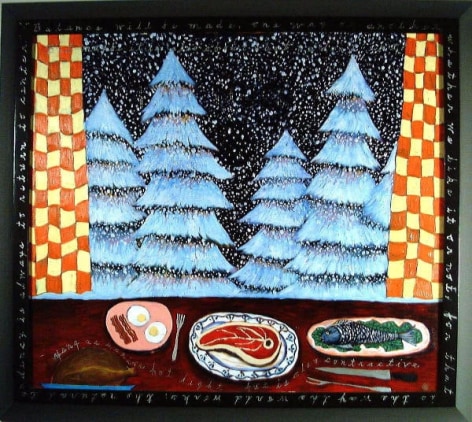
But Maybe it is Also About What We Don't Eat
1995
Oil on canvas with painted frame
32 x 36 inches
HS 61
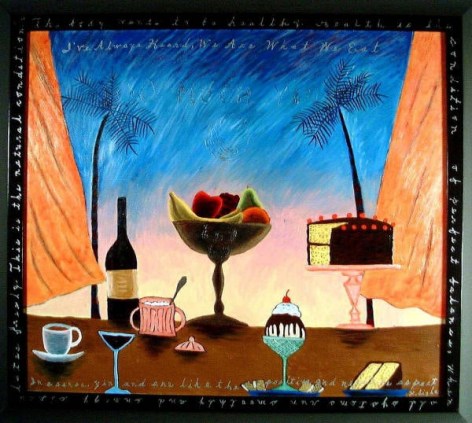
But Maybe it is Also About What We Don't Eat
1995
Oil on canvas with painted frame
32 x 36 inches
HS 61
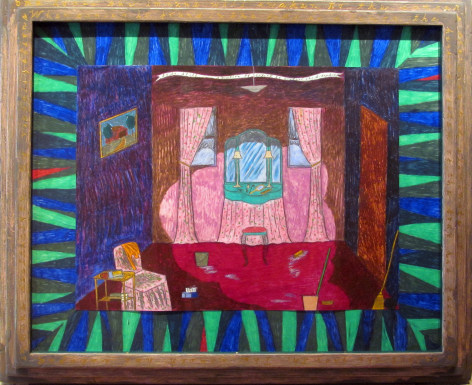
It Is Still a Question of Trying to Control the Situation
Oil pastel on paper, painted frame
29 x 34 inches
MP 01
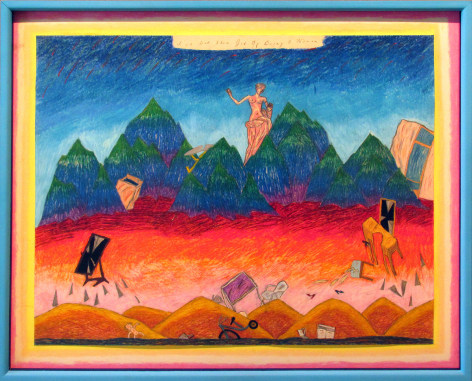
I’ve Got the Job of Being a Woman
1982
Oil pastel on paper
28 ¼ x 34 ¼ inches
HS 77
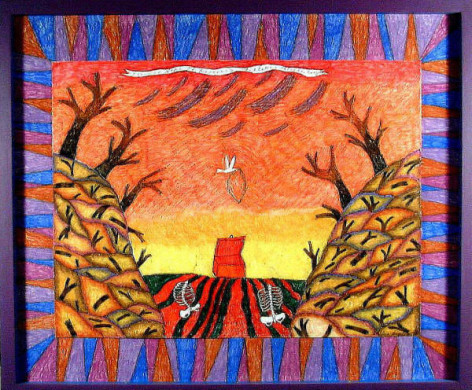
Renewed Hope of Recovery Fill Her Thoughts Every Day
1998
Oil, pastel on paper with painted frame
24 x 29 inches
HS 64

And Peace on Earth, Goodwill Towards Men
2000
Oil on canvas
78 x 102 inches
6 ½ x 8 ½ feet (framed)
HS 67
exhibited: HOLLIS SIGLER: expect the Unexpected, Rockford Art Museum and Chicago Cultural Center, October2009-April, 2010. Illustrated: exhibition catalog, p. 83, 2009.
SOLD
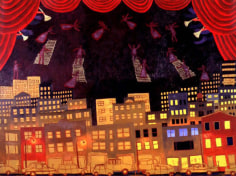
Handel's Messiah Series
2001
oil on canvas
72 x 96 inches
HS68
Contemplating the Risk
oil on canvas with artist painted frame
45 x 62 inches
1981
HS74
The Land of the Disinherited
oil on canvas with artist's painted frame
60 x 60 inches
1987
HS73
.
Hollis Sigler's Breast Cancer Journal
"Sigler's entire career has been a testament to the communicative graces of art,
and in the Breast Cancer Journal she reminds us
that art can accomplish this in a way that nothing else can,
and that sometimes, preciously and rarely, it will do very much more.
Sometimes art can be a matter of life and death." - James Yood
Hollis Sigler, a leading feminist artist, was diagnosed in 1985 with breast cancer, a disease that had also stricken her mother and great-grandmother. After it recurred, she began a pictorial journal, now encompassing more than one hundred works. Art in America magazine called Sigler's Breast Cancer Journal "one of contemporary art's richest and most poignant treatments of sickness and health… Taking on a kind of religious conviction, her jewel-colored symbols imbue a death-haunted situation with miraculous, celebratory life." These works- and the commentaries that the artist inscribed on many of them- combine personal experience with family history, medical statistics, and political consciousness raising.
This inspiring volume brings together the si x ty finest works from the Breast Cancer Journal in full-color reproductions- paintings, drawings, prints, watercolors, and cut-paper pieces- each accompanied by the artist's commentaries. Dr. Susan M. Love, a leading authority on breast cancer, discusses the importance of Sigler's art as a document on the disease's personal impact. "Hollis Sigler gives a voice to the woman struggling with the reality of breast cancer- not the ever-happy face the public wants to see, but the real face of a woman living with a chronic and potentially life-threatening disease. It is this reality that makes her art so difficult for many women to face, and it is this reality that also makes it so powerful."
James Yood recounts the aesthetic trajectory of Sigler's career, and of the Breast Cancer Journal in particular, drawing parallels with Frida Kahlo, another artist whose life and work were significantly affected by a medical condition. He is also "reminded of late works by Rembrandt or Pablo Picasso or Ivan Albright, when these artists looked squarely in the face of their death." He writes of Sigler: "In work after work she explores what it means to love, to enjoy small pleasures, to consider both the wonder and the ambiguities of human relationships, and to inventory the thousand tender wounds of intimacy… Sigler's images, with their titles often scrawled across them, constitute a corpus of work revealing the possibilities for a genre painting of the human spirit at the end of the twentieth century."
Sigler herself, in an essay titled "To Kiss the Spirits," writes of her life as a woman, as a lesbian, as an artist, as a person with breast cancer, and as a breast cancer activist, also relating the history of various art projects and exhibitions that culminated in her Breast Cancer Journal, a project undertaken with the hope that "the work would thus gain the power to destroy the silence surrounding the disease." She also discusses many metaphoric images that appear and reappear in the work, such as the vanity and its mirror, a dead and broken tree, her mother's dress, and the Winged Victory of Samothrace. The titles of the paintings alone provide a poignant glimpse into the mind and spirit of this remarkable artist:
The Illusion Was to Think She Had Any Control over Her Life
Trying to Maintain an Air of Normalcy
The Future Moves in Much Closer
What Does the Lady Do with Her Rage?
Following the Ghosts of Our Grandmothers into the Future
In Spite of All, She Rises in the Morning with Joy in Her Heart
Wishing She Could Take a Vacation from Her Disease
It Starts with One Errant Cell
A Wish to Touch the Sky
In the Unfolding of Life, Every Minute Is Precious
She Had No More Room for Sorrow
We Have Sold Our Souls to the Devil
Hollis Sigler’s Breast Cancer Journal is a beautiful art book and a unique testament to the human spirit, a fundamental affirmation of the possibilities of life discovered in the midst of agony and loss. To be published during National Breast Cancer Month, October 1999, it is the artist’s gift to all whose lives have been touched by this disease.
Dr. Susan M. Love is the bestselling author of Dr. Susan Love’s Breast Book (Addison Wesley, 1990/1995) and Dr. Susan Love’s Hormone Book (Random House, 1997). A breast cancer surgeon, researcher, scholar, teacher, and activist, she studies and taught at Harvard Medical School before moving to the U.C.L.A. School of Medicine. She is also Medical Director of the Santa Barbara Breast Cancer Institute and one of the founders of the National Breast Cancer Coalition. She has been appointed to the National Cancer Advisory Board.
James Yood, born in Elizabeth, N.J., studied at the Universities of Wisconsin (B.A.) and Chicago (M.A., Ph.D. candidate). He teaches at Northwestern University in Chicago and is the author of many books on Chicago art and artists.
Published by Hudson Hills Press
Hardcover: Retail price $45; ISBN 1-55595-175-9
Paperback: Retail price $25; ISBN 1-55595-176-7
Library of Congress Number 99-32014; CIP
96 pages; 9 x 12 inches, 60 color plates, 1 black-and-white portrait of the artist
Like all Hudson Hills Press books, this fine volume is printed on permanent alkaline paper.
“In the face of terminal illness, those afflicted have been known to do extraordinary things. While compelled to cope with the physical effects of disease, many artists, writers, and performers have created works directly related to or informed by illness. Confronted with a new identity and status as ‘sick person,’ they have questioned the meaning of life, fate, and destiny or addressed social and political issues surrounding their illness. An energy and freedom seem to follow the diagnosis of a disease that will remain with a person for the rest of her life.
Hollis Sigler’s Breast Cancer Journal is a public acknowledgement of her longtime battle with breast cancer. First diagnosed in 1985, Sigler was told seven years later that the cancer had metastasized to her bones. Responding to the disease’s permanence, it seemed natural, unavoidable, to incorporate breast cancer into her art. Since the mid-1970’s, Sigler’s continuing pictorial diary of confessional paintings and drawings has revealed her desires and fantasies, as well as her fears and sorrows. Rendered with a vibrant palette and a childlike simplicity, her fictional spaces scattered with personal effects symbolize complexand intense emotional states. Though Sigler continues to employ her vigorous yet delicate style, the content of her works shifted dramatically when she found the cancer had spread. Accepting her social responsibility as an artist, she decided to incorporate the ‘cause’ into her work. “
- Stacy Boris

